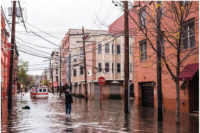The effects of Hurricane Sandy, later evolving into Superstorm Sandy, were severe for the security industry as they were for residents of the East Coast and other industries. The combination of blackouts that left alarm systems to rely on backup batteries, the interminable lines at gas stations in New York and New Jersey that put service vehicles out of commission and the strain put on cell towers and other communications conspired to make being a security dealer on the East Coast an even tougher job than usual.
The hurricane made landfall on the eve of what was to be Security Week, which was scheduled to open with the ISC East show on Tuesday Oct. 30. Due to the State of Emergency declared by the Governor of the State of New York and the clear impact and potential danger presented by Hurricane Sandy, ISC Events decided to postpone ISC East.
As ISC East was rescheduled, organizers wanted to highlight the importance of a strong security industry community that could rise back up after a natural disaster like Sandy and learn from each other. Attendees of ISC East, taking place Nov. 28 and 29, 2012 at the Jacob Javits Convention Center in New York, will have opportunities to network with others on their approach to recovering from the storm and what they learned. It will also provide an opportunity for the industry to give back as ISC and SIA will make a contribution on the industry’s behalf to a hurricane relief fund.
As SDM spoke with East Coast dealers affected by the storm, they all seemed to agree that this may have been the worst storm they’ve seen but it won’t be the last. And that learning from their own experiences as well as their peers’ could make all the difference in the future.
Dave Engebretson, president of Slayton Solutions, has been in the security industry for more than 25 years and was in New York City during the initial stages of cleanup after Sandy. He commented, “For security dealers, in any kind of huge weather event, the first thing that happens is getting a ton of false alarms… When I worked at a central station we could track a storm from where calls came from.”
Because the severity storm was well-publicized and because central stations continually monitor the weather, security companies on the East Coast were able to take measures to prepare for the elevated alarm volumes that were to come in. Companies such as American Alarm, Arlington, Mass., Electronix Systems, Huntington Sta., N.Y., Supreme Security Systems, Union, N.J., Vintage Security, Md. And Vision Monitoring, Garden City, N.Y. made sure days in advance to adjust staff schedules and take a worst-case scenario approach to staffing.
Dave Young, vice president of Vision Monitoring, commented, “In advance of the storm our staff went on preparedness alert about 4-days prior to it coming ashore.... In a normal week our central station would receive 30,000 signals and operators would handle 7,000 a week. After Sandy struck our central station had 130,000 signals and operators handled 32,000 a week… We housed our staff onsite and made sure that the next shift could get into work. We had overlapping of shifts just in case conditions changed to avoid any interruptions. We also had carpooling plans and were assessing where employees lived depending on the more heavily damaged areas.”
In a crisis situation where power is wiped out in large geographic areas during a storm, the vast majority, if not 100 percent of signals and calls going into a central station or alarm company are due to AC power loss that either causes the system to shut down completely or go into battery backup mode for the duration of that battery’s remaining life. The how-do-I-get-the-panel-to-stop-beeping calls go on for days and visiting residential customers to replace backup batteries every few days, or hours in some cases, is not always a feasible option when there is no accurate expectation of when power will be restored, dealers said.
Jeff Smith, commercial division manager, Vintage Security, shared that, “Power grids in Maryland are up there with the worst ones in the United States.” With 16,000 customers, the phones rang nonstop 24/7 and the company had its technicians on the phone helping customers silence their alarms. The company made use of its social media platform by posting links and instructions on how to silence alarms on Facebook and Twitter. Smith noted that the company has only been active in social media for the past eight to ten months, and this was an unexpected but effective use of it.
Especially in the case of commercial accounts such as jewelry stores, however, an extended period without power and without a security system can result in major loss. Electronix Security worked with commercial customers by providing patrol and guard tours at regular intervals. “We picked up an attempted break in at jewelry store,” Leonardo said. The back door had been broken into but no items were taken. The burglars must have seen the guards and been scared away, Leonardo concluded. “On our real high end jobs, we would go out and replace batteries to give them protection as long as they have a way to transmit it back to the office.”
That is, even if a generator or backup battery kept the system “alive,” damaged phone lines and internet networks, as well as congested and power-less cellular towers kept systems offline during the height of the storm and days after.
Roberto Bitton, chief executive officer of Supreme Security Systems said some commercial customers requested extra batteries they could replace themselves. “The lesson is that on certain high-risk, key accounts, we may want to talk to those customers to offer battery backup of greater power.”
Michael Flink, president of ADI, Melville, N.Y., said the company sold every battery it had on the East Coast, though it quickly replenished inventory coming from its Texas warehouse. Some of the larger ADI customers were placing orders for upwards of 10,000 batteries. Flink reflected that the East Coast has a comparatively higher security system penetration rate than the rest of the country, and the number of affected systems was astronomical.
Michael Ash, president at Garden State Fire & Security Alarm Co., Matawan, N.J. was faced with a blackout at his facility that lasted a week. During that time, the company ran on generators and relied on cell phones for communication and for providing internet through hot spots. The company’s alarm monitoring is done through third-party central station, SentryNet, located in Pensacola, Fla. and that allowed the company to continue servicing its customers. Because phones and networks were down at the company headquarters, the lines were forwarded to SentryNet. Garden State would then call the central station on cell phones and pick up 10 or 15 service calls at a time. “We handled hundreds of calls but weren’t able to put vehicles on the road. It took us three days to get back out there because roads were blocked to all but emergency vehicles.”
Sunita Sukhu of Sabre Integrated Security Systems, LLC, New York, shared that its office in downtown New York City lost power,, internet and phone service on Oct. 29 and did not regain it until Nov. 11. “This was difficult for so many of our clients as many of them had power as midtown and upper NYC remained with power,” Sukhu said. “As the days went on and the damage to our client's CCTV and access control systems were being evaluated by our clients, they still had no way to reach us to let us know that they needed our help.”
When the power finally returned, the company began the long process of contacting its clients to evaluate damage and reaching out to those who had been waiting to get in touch with the company. “As we have slowly helping our clients rebuild their systems, some of our clients are still assessing building damage from flooding waters,” Sukhu added. “Even at this point in time, some businesses in NYC are not back up and running because of Sandy and there is a lot of work to be done to help them get their systems back up and running.”
For those who remained operational through the first few days after the storm, fuel shortages and lines 100 cars long were a big issue for alarm dealers who needed to provide fuel for their service vehicles. Engebretson shared the story of a limo driver in New York, who got up at 4 a.m., spent $36 in tolls to get to a less affected area of New Jersey to fill his own tank as well as gallons in gas cans to take back to New York.
Bitton had a similar story. His technicians could not afford to sit the three to five hour lines at the gas stations nearby. “We went to home depot and bought all of their little red gas cans. And then we sent the truck 40 miles west and filled up all those cans to pour them into our trucks.”
Electronix Security, said president Fred Leonardo, had on inside track on when and where gas deliveries were made to the stations to avoid even longer waits or fruitless trips. The other issue, Leonardo added, is that “you needed cash [to get fuel] because the internet service at the local gas stations were down and they couldn’t process credit cards.” He added that the company was faced with similar problem in August of 2004 during a two-day blackout and was prepared with cash in hand this time.
Ironically, this is time when service vehicles work overtime, as companies have to handle additional service calls for equipment damage and water damage: alarms going into trouble, wires becoming loose, wires getting shorted, basements (and subsequently, panels) going underwater, and more.
“With any storm predicted a central station should be over prepared for what can come their way in terms of weather related or man-made disasters,” said Young. “Hurricane Irene was the warning shot just a year earlier and one we came through prepared as well. The super storm Sandy sadly lived up to predictions.”
Young added, “While our neighbors experienced outages we had full emergency generator backups with generators standing by should one fail. We did not have Internet but we did have all our redundant communications working fully throughout the storm and its aftermath. We did not have to shut down.
We have an emergency contingency plan for our central station. As a UL-Listed central station and New York City Fire Approved, we have a plan for the plan, and another plan for that plan.”
At the time of writing in late November, these companies and hundreds of others were hard at work helping their customers recover full use of their security systems, assessing varying degrees of damage on properties and working with insurance companies to estimate losses.
Ash added that while the company is helping its customers get back on their feet, the recovery period is just beginning. “This will be going on for years because the damage is unreal.” For people who lost their homes, or suffered severe flood damage rebuilding will be a long and arduous process, Ash said. For many of them, the status of their alarm system is on the backburner.

